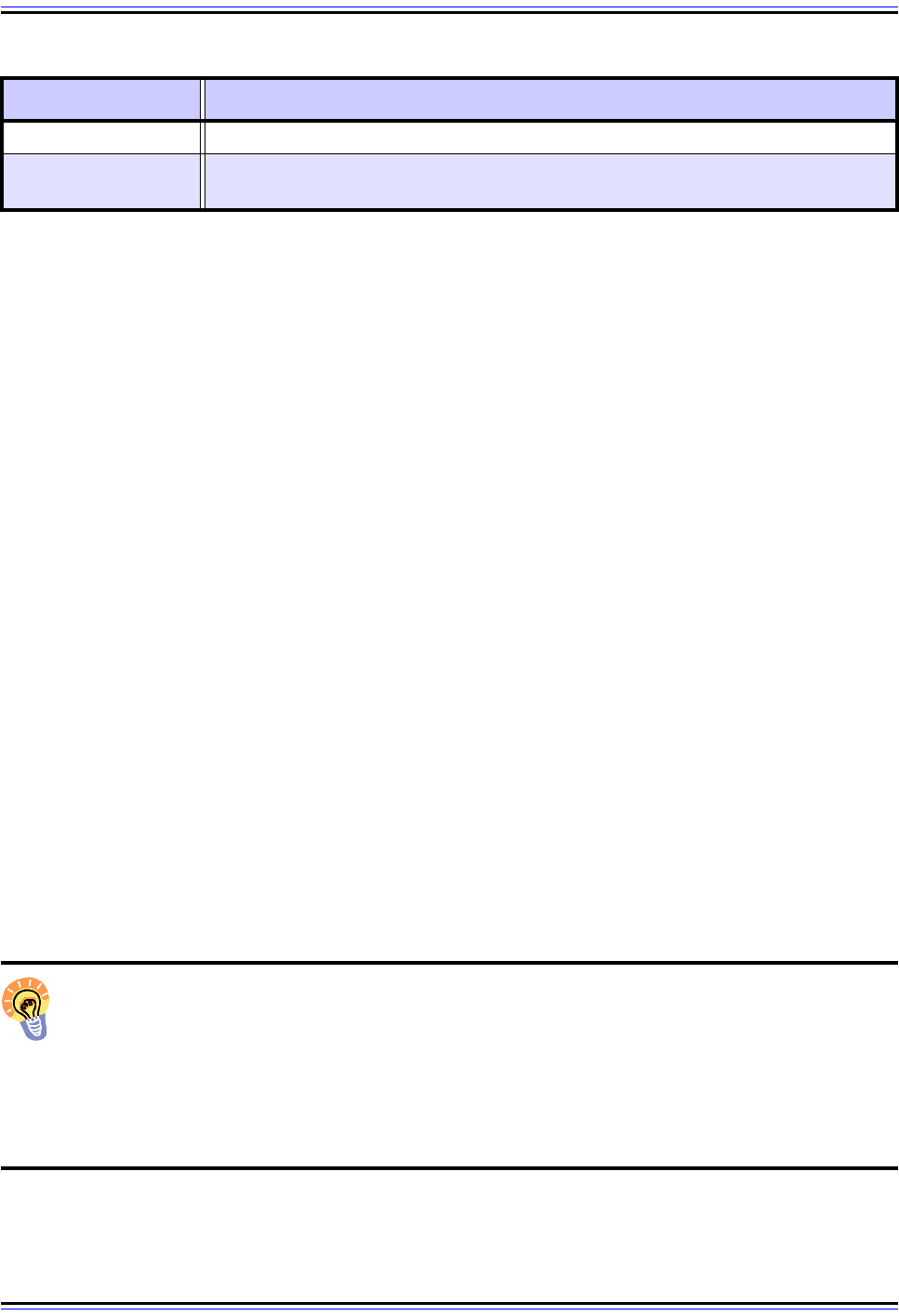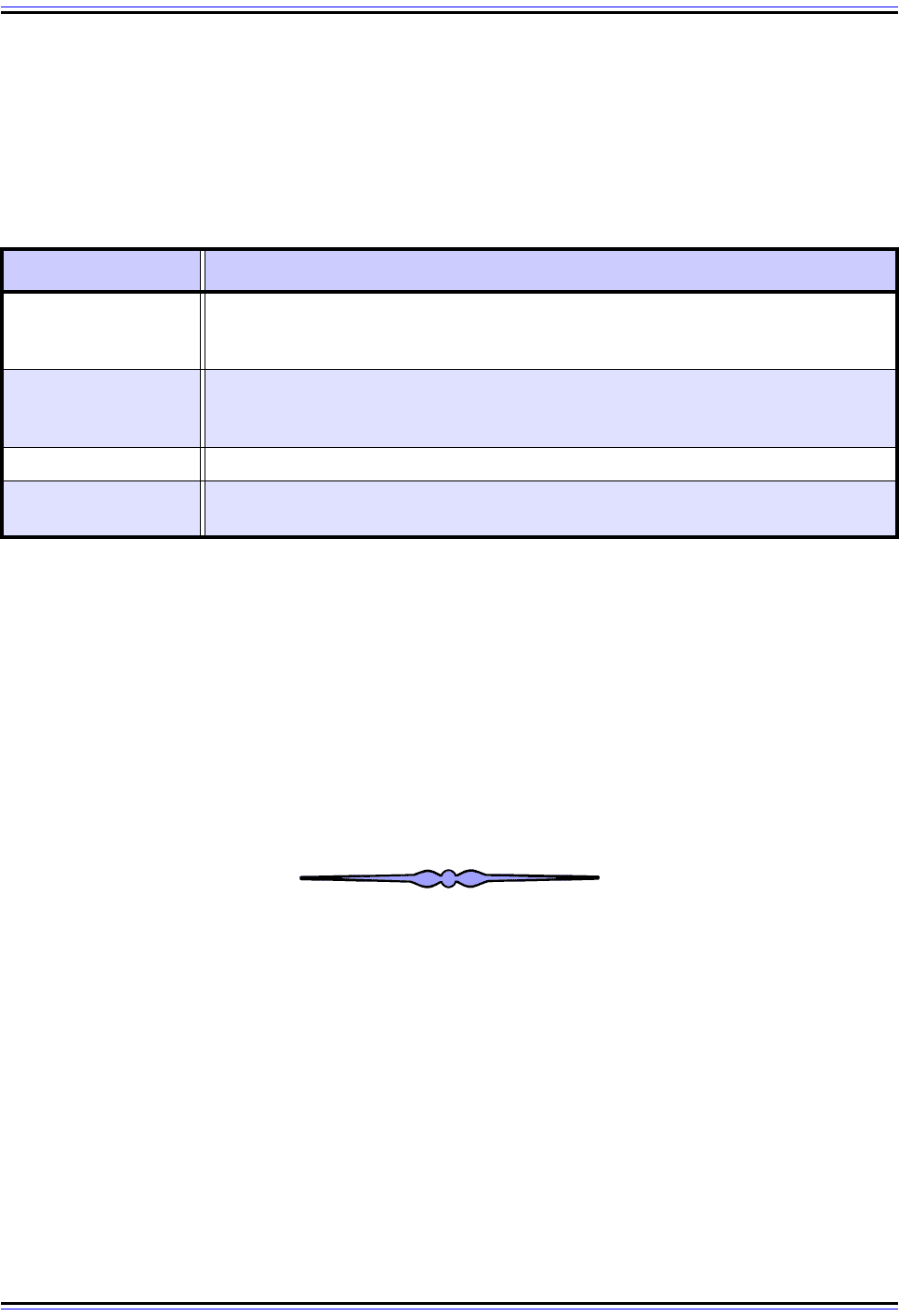Charles M. Kozierok The TCP-IP Guide
Подождите немного. Документ загружается.


The TCP/IP Guide - Version 3.0 (Contents) ` 1491 _ © 2001-2005 Charles M. Kozierok. All Rights Reserved.
Usenet Newsgroup Hierarchies
The total collection of newsgroup hierarchies is in many ways similar to the domain name
tree structure used in DNS. Each Usenet hierarchy is like a collection of all the domain
names within a DNS top-level domain. Just as a domain name like www.pcguide.com is
formed by appending the label of the top level domain “com” to the second-level domain
name “pcguide” and the subdomain “www”, newsgroup names are created in the same
way. They are created from a top-level newsgroup hierarchy name, to which are attached a
set of descriptive label that describe the newsgroup's place in the hierarchy.
One difference between DNS and Usenet hierarchies is that while DNS names are created
from right to left as you go “down the tree”, Usenet newsgroup names are formed in the
more “natural” (for English speakers) left to right order. For example, one of the main
Usenet hierarchies is the “comp” hierarchy, devoted to computer topics. Within “comp” is a
sub-hierarchy on data communications called “dcom”, and within that a group that
discusses data cabling. This group is called comp.dcom.cabling. Almost all newsgroups are
structured in this manner.
The "Big Eight" Newsgroup Hierarchies
One problem with the “decentralized, anarchistic” nature of Usenet is ensuring coordination
in certain areas where we want everyone to be on the same page; one of these is
newsgroup naming. If we let just anyone create a newsgroup, we might well end up with
many, even dozens of groups that all discuss the same topic. Imagine that someone had a
question on data cabling and didn't realize that comp.dcom.cabling existed, so they created
a new group called comp.datacomm.cabling. The two groups could coexist, but this would
lead to both confusion and fragmenting of the pool of people interested in this topic.
To avoid this problem, many of the administrators of large Usenet systems collaborated on
a system for organizing many of the more commonly-used Usenet groups into eight hierar-
chies, and devised a specific procedure for creating new newsgroups within them. There is
a actually a long history behind how this came about; these are today called the Big Eight
Usenet hierarchies, and are summarized in Table 264.
Table 264: Usenet “Big Eight” Newsgroup Hierarchies
Hierarchy Description
comp.*
Newsgroups discussing computer-related topics, including hardware, software,
operating systems and techniques.
humanities.* Groups discussing the humanities, such as literature and art.
misc.* Miscellaneous topics that don't fit into other Big Eight hierarchies.
news.* Groups discussing Usenet itself and its administration.
rec.* Recreation topics, such as games, sports and activities.
sci.*
Science newsgroups, covering specific areas such as physics and chemistry,
research topics and so forth.

The TCP/IP Guide - Version 3.0 (Contents) ` 1492 _ © 2001-2005 Charles M. Kozierok. All Rights Reserved.
These eight hierarchies contain many of the most widely-used groups on Usenet today. For
example, professional baseball is discussed in rec.sport.baseball, Intel computers in
comp.sys.intel and Middle East politics in talk.politics.mideast.
The Big Eight hierarchies are rather tightly controlled in terms of their structure and the
newsgroups they contain. The process to create a new Big Eight newsgroup is democratic
and open; anyone can propose a new group and if there is enough support, it will be
created by the cooperating system administrators who agree to follow the Big Eight system.
However, this creation process is rather complex and time-consuming. Some people find
this unacceptable and even object to the entire concept of this restricted process; others
consider it advantageous, as it keeps the Big Eight hierarchies relatively “orderly” by
slowing the rate of change to existing newsgroups and the number of new groups added.
Other Newsgroup Hierarchies
For those who prefer a more free-wheeling environment and do not want to submit to the
Big Eight procedures, there is the “alternative” Usenet hierarchy, which begins with the
hierarchy name alt. This hierarchy includes many thousands of groups. Some are quite
popular, but many are not used at all; this is a side-effect of the relative ease with which an
alt group can be created.
In addition to these nine hierarchies there are dozens of additional, smaller hierarchies.
Many of these are regional or even company-specific. For example, the “ne.” hierarchy
contains a set of newsgroups discussing issues of relevance to New England; “fr.*” covers
France, and “de.*” Germany. Microsoft has its own set of public newsgroups in the
“microsoft.*” hierarchy. Figure 311 shows the Big Eight hierarchies and some of the other
hierarchies that exist.
Key Concept: Usenet messages are not addressed to individual users; rather, they
are posted to newsgroups. Each newsgroup represents a topic; those with an
interest in the subject of a group can read messages in it, and reply to them as well.
Usenet newsgroups are arranged into tree-like hierarchies that are similar in structure to
DNS domains. Many of the most widely-used newsgroups are found in a collection of
general-interest hierarchies called the Big Eight. There are also many regional and special-
purpose hierarchies.
soc.* Society and social discussions, including groups on specific cultures.
talk.*
Groups primarily oriented around discussion and debate of current events and
happenings.
Table 264: Usenet “Big Eight” Newsgroup Hierarchies
Hierarchy Description

The TCP/IP Guide - Version 3.0 (Contents) ` 1493 _ © 2001-2005 Charles M. Kozierok. All Rights Reserved.
Unmoderated and Moderated Newsgroups
Most newsgroups are open to all to use, and are called unmoderated because a message
sent to them goes directly out to the whole Usenet server internetwork. In contrast, a small
percentage of newsgroups is moderated, which means that all messages sent to the group
are screened and only the ones that are approved by a moderator (or moderator team) are
really posted.
The purpose of moderated groups is to ensure that discussions in a particular group remain
on-topic. They are often created to handle topics that are controversial, to ensure that
debates remain constructive and disruption is avoided. For example, rec.guns is moderated
to ensure that discussions focus on the use of guns and not on endless political arguments
related to gun control and the like (which has a place, in talk.politics.guns).
Moderated groups are also sometimes used for specialty groups intended only for
announcements, or for groups where the content is restricted. For example,
rec.food.recipes is moderated so that it only contains recipes and recipe requests; this
helps people find recipes easily without having to wade through lots of discussion. Finally,
moderated versions of unmoderated groups are sometimes created when a few disruptive
elements choose to post large volumes in the unmoderated groups, making normal
discussion difficult.
Figure 311: Usenet Newsgroup Hierarchies
Usenet newsgroups are arranged into tree-like structures called hierarchies. Eight of these are centralized,
widely-used, general-purpose hierarchies, which are today called the “Big Eight”. The “alternate” (“alt”)
hierarchy is a very loosely-structured set of thousands of groups covering every topic imaginable. In addition
to these, there are many hundreds of regional, private and special-purpose hierarchies.
Root
comp.*
humanities.*
misc.*
new s.*
rec.*
sci.*
soc.*
talk.* alt.*
can.*, ne.*, ... adobe.*,
microsoft.*, ...
"Big Eight" Usenet Hiearchies
"Alternate"
Hierarchy
Regional
Hierarchies
Private / Special-
Purpose
Hierarchies

The TCP/IP Guide - Version 3.0 (Contents) ` 1494 _ © 2001-2005 Charles M. Kozierok. All Rights Reserved.
Cross-Posting to Multiple Newsgroups
It is possible for a single article to be posted to multiple newsgroups. This process, called
cross-posting, is used when a message pertains to two topics, or to allow a sender to reach
a wider audience. For example, if I live in the Seattle area and have a problem with my
house, I might legitimately cross-post to seattle.general and misc.consumers.house.
This is more efficient than posting the same message to each group independently for two
reasons. First, only one copy of the message will be stored on each Usenet server rather
than two. Second, Usenet participants who happen to read both groups won't see the
message twice. However, cross-posting to very large numbers of newsgroups is usually
considered disruptive and a breach of Usenet etiquette.
Usenet Message Format and Special Headers
Usenet is designed to permit users to exchange information in the form of messages that
are sent from one computer to another. Like any message-based networking application, it
is necessary that all Usenet client and server software agree to use a common message
format. This ensures that all devices and programs are able to interpret all Usenet articles in
a consistent manner.
General Message Format
While Usenet was created as an alternative to e-mail, and there are obviously differences in
how each treats messages, there are also many similarities. Both are text-oriented
messaging systems with similar needs for communicating both content and control infor-
mation. The creators of Usenet realized that there would be many advantages to basing the
Usenet message format on the one used for e-mail, rather than creating a new format from
scratch. For one thing, the e-mail message format was already widely used, and adopting it
for Usenet would save implementation time and effort. It would also enhance compatibility
between e-mail and Usenet messages, allowing software designed to process or display e-
mail to also work with Usenet articles.
For this reason, the Usenet message format was defined based on the RFC 822 standard
for e-mail messages, discussed thoroughly in its own subsection of the section on e-mail in
this Guide. RFC 822 messages begin with a set of headers that contain control and
descriptive information about the message, followed by a blank line and then the message
body, which contains the actual content.
One important attribute of the RFC 822 standard is the ability to define custom headers that
add to the regular set of headers defined in the standard itself. Usenet articles require some
types of information not needed by e-mail, and these can be included in specially-defined
headers while still adhering to the basic RFC 822 format. At the same time, headers
specific to e-mail that are not needed for Usenet can be omitted.

The TCP/IP Guide - Version 3.0 (Contents) ` 1495 _ © 2001-2005 Charles M. Kozierok. All Rights Reserved.
Thus, there is no structural difference at all between a Usenet article and an e-mail
message; they differ only in the kinds of headers they contain, and the values for those
headers. For example, a Usenet message will always contain a header specifying the
newsgroup(s) to which the article is being posted, but will not carry a “To:” line as an e-mail
message would.
Key Concept: Usenet articles use the same RFC 822 message format as electronic
mail messages. The only difference between a Usenet article and e-mail message is
in the header types and values used in each.
Usenet Header Categories and Common Headers
All Usenet headers are defined according to the standard header format defined in RFC
822:
<header name>: <header value>
As with e-mail messages, headers may extend on to multiple lines, following the indenting
procedure described in the RFC 822 standard.
The current standard for Usenet messages, RFC 1036, describes the header types for
Usenet messages. The headers are divided into two categories: mandatory headers and
optional headers. Some are the same as headers of the equivalent name used for e-mail,
some are similar to e-mail headers but used in a slightly different way, while others are
unique to Usenet. Table 265 describes these header fields and how they are used.

The TCP/IP Guide - Version 3.0 (Contents) ` 1496 _ © 2001-2005 Charles M. Kozierok. All Rights Reserved.
Table 265: Usenet Header Categories and Headers (Page 1 of 2)
Header
Category
Header Name Description
Mandatory
Headers
From: The e-mail address of the user sending the message, as for e-mail.
Date:
The date and time that the message was originally posted to Usenet. This
is usually the date/time that the user submitted the article to his or her
local NNTP server.
Newsgroups:
Indicates the newsgroup or set of newsgroups to which the message is
being posted. Multiple newsgroups are specified by separating them with
a comma; for example: “Newsgroups: news.onegroup,rec.secondgroup”.
Subject:
Describes the subject or topic of the message. Note that this header is
mandatory on Usenet despite being optional for e-mail; it is important
because it is used by readers to decide what messages to open.
Message-ID:
Provides a unique code for identifying a message; normally generated
when a message is sent. The message ID is very important in Usenet,
arguably more so than in e-mail. The reason is that delivery of e-mail is
performed based on recipient e-mail addresses, while the propagation of
Usenet messages is controlled using the message ID header.
Path:
This is an informational field that shows the path of servers that a
particular copy of a message followed to get to the server where it is being
read. Each time a server forwards a Usenet article, it adds its own name to
the list in the Path header. The entries are usually separated by excla-
mation points.
For example, if a user on Usenet server A posts a message, and it is
transported from A to G, then X, then F and finally to the server Q where a
second user reads it, the person on server Q would see something like
this in the Path header: “Q!F!X!G!A”.
Optional
Headers
(part 1 of 2)
Reply-To:
It is possible to reply back to a Usenet article author using e-mail, which by
default goes to the address in the From: line. If this header is present, the
address it contains is used instead of the default From: address.
Sender:
This header indicates the e-mail address of the user who is sending the
message, if different from the message originator. This is functionally the
same as the Sender: header in e-mail messages, but is used in a slightly
different way. Normally, when a Usenet message is posted, the sender's
e-mail address is automatically filled in to the From: line. If the user
manually specifies a different From: line, the address from which the
message was actually sent is usually included in the Sender: line. This is
used to track the true originating point of articles.
Followup-To:
A reply to a Usenet message is usually made back to Usenet itself, and is
called a follow-up. By default, a follow-up goes to the newsgroup(s)
specified in the original message's Newsgroups: header. However, if the
Followup-To: header is included, follow-ups to that message go to the
newsgroups specified in the Followup-To: header instead.
This header is sometimes used to “route” replies to a message to a
particular group. Note, however, that when a user replies to a message,
this field only controls what appears in the new message's Newsgroups:
line by default. The user can override the Newsgroups: header manually.

The TCP/IP Guide - Version 3.0 (Contents) ` 1497 _ © 2001-2005 Charles M. Kozierok. All Rights Reserved.
Additional Usenet Headers
Usenet messages may also contain additional headers, just as is the case with e-mail
messages. Some of these headers are entirely “custom” and are included by individual
users to provide extra information about an article. Others are used in many or even most
Optional
Headers
(part 2 of 2)
Expires:
All Usenet messages are maintained on each server for only a certain
period of time, due to storage limitations. The expiration interval for each
newsgroup is controlled by the administrator of each site. If present, this
line requests a different expiration for a particular message; it is usually
used only for special articles. For example, if a weekly announcement is
posted every Monday morning, each article might be set to expire the
following Monday morning, to make sure that people see the most current
version.
References:
This header lists the message IDs of prior messages in a conversation.
For example, if someone posts a question to a newsgroup with message
ID “AA207”, and a reply to that message is made, the software will
automatically insert the line “References: AA207” into the reply. This is
used by software to group together articles into conversations (called
threads) to make it easier to follow discussions on busy newsgroups.
Control:
Indicates that the article is a control message and specifies a control
action to be performed, such as creating a new newsgroup.
Distribution:
By default, most messages are propagated on Usenet worldwide. If
specified, this line restricts the distribution of a message to a smaller area,
either geographical or organizational.
Organization:
Describes the organization to which the article sender belongs. Often filled
in automatically with the name of the user’s Internet Service Provider.
Keywords:
Contains a list of comma-separated keywords that may be of use to the
readers of the message. Keywords can be useful when searching for
messages on a particular subject matter. This header is not often used.
Summary: A short summary of the message; again, rarely used in practice.
Approved:
This header is added by the moderator of a moderated newsgroup to tell
the Usenet software that the message has been approved for posting.
Lines: A count of the number of lines in the message.
Xref:
While Usenet articles are identified by message ID, they are also given a
number by each Usenet server as they are received. These article
numbers, which differ from one system to the next, are usually listed in
this cross-reference header.
This information is used when a message is cross-posted to multiple
groups. In that case, as soon as a user reads the message in one group, it
is marked as having been read in all the others where it was posted. This
way, if the user later reads one of those other groups, they will not see the
message again.
Table 265: Usenet Header Categories and Headers (Page 2 of 2)
Header
Category
Header Name Description

The TCP/IP Guide - Version 3.0 (Contents) ` 1498 _ © 2001-2005 Charles M. Kozierok. All Rights Reserved.
current Usenet articles, and have become almost “de facto” standard headers through
common use. Many of these custom headers are preceded by “X-”, indicating that they are
“experimental” or “extra” headers.
Some of the more frequently encountered “additional” Usenet headers are shown in Ta bl e
266.
Usenet MIME Messages
Since Usenet follows the RFC 822 standard, Multipurpose Internet Mail Extensions (MIME)
can be used to format Usenet messages. When this is done, you will see the usual MIME
headers (such as MIME-Version, Content-Type and so forth) in the message.
Note that the use of MIME in Usenet messages is somewhat controversial. Some
newsreaders are not MIME-compliant and make a mess when trying to display some of
these messages, and many Usenet veterans object to the use of anything but plain text in
Usenet messages. Despite this, MIME messages are becoming more common, for better or
worse.
Table 266: Common Additional Usenet Headers
Header Name Description
NNTP-Posting-Host:
Specifies the IP address or the DNS domain name of the host used to originally
post the message. This is usually either the address of the client that the author
used for posting the message, or the sender's local NNTP server.
User-Agent:
(or)
X-Newsreader:
The name and version number of the software used to post the message.
X-Trace: Provides additional information that can be used to trace the message.
X-Complaints-To:
An e-mail address to use to report abusive messages. This header is now included
automatically by many Internet Service Providers.

The TCP/IP Guide - Version 3.0 (Contents) ` 1499 _ © 2001-2005 Charles M. Kozierok. All Rights Reserved.
TCP/IP Network News Transfer Protocol (NNTP)
Usenet started out as an informal network of UNIX computers using dial-up UUCP connec-
tions to transmit messages between servers. This arrangement arose out of necessity, and
it worked fairly well, though it had a number of problems. Once the Internet became widely
used in the 1980s, it provided the ideal opportunity for a more efficient means of distributing
Usenet articles. A special TCP/IP protocol was developed for sending these messages,
called the Network News Transfer Protocol (NNTP). NNTP is used today to carry billions of
copies of Usenet messages from computer to computer every day.
In this section I provide a detailed description of the operation of the Network News Transfer
Protocol. I begin with an overview of how NNTP works in general terms. I then explain the
two fundamentals ways that NNTP is used: for the propagation of news articles between
servers, and for client article posting and access. I then provide more information about
standard NNTP commands, as well as the newer NNTP command extensions, and also
illustrate NNTP status responses and the common response codes.
Background Information: NNTP is similar to the Simple Mail Transfer Protocol
(SMTP) in many ways, including its basic operation and command set and reply
format. You may therefore find this section easier to understand if you are familiar
with SMTP.
NNTP Overview and General Operation
Usenet began as a logical internetwork of cooperating hosts that contacted each other
directly. In the early Usenet, a user would post a message to his or her local server. There it
would stay until that server either contacted or was contacted by another server. The
message would then be transferred to the new server, where it would stay until the second
server contacted a third one, and so on.
This transport mechanism was functional, but seriously flawed in a number of ways.
Servers were not continually connected to each other; they could only communicate by
making a telephone call using an analog modem. Thus, messages would often sit for hours
before they could be propagated. Modems in those days were also very slow by today's
standards—2400 bits per second or even less—so it took a long time to copy a message
from one server to another. Worst of all, unless two sites were in the same city, these phone
calls were long distance, making them quite expensive.
Why was this system used despite all of these problems? Simple: there was no alternative.
In the late 1970s and early 1980s, there was no Internet as we know it, and no other
physical infrastructure existed to link Usenet sites together. It was either use UUCP over
telephone lines, or nothing.

The TCP/IP Guide - Version 3.0 (Contents) ` 1500 _ © 2001-2005 Charles M. Kozierok. All Rights Reserved.
The Development of NNTP
Everything changed as the fledgling ARPAnet grew into the modern Internet. As the Internet
expanded, more and more sites connected to it, including many sites that were participating
in Usenet. Once a pair of sites were both on the Internet, it was an easy decision to use the
Internet to send Usenet articles rather than slow, expensive telephone calls. Over time,
more and more Usenet sites joined the Internet, and it became clear that just as e-mail had
moved from UUCP to the TCP/IP Internet, the future of Usenet was on the Internet as well.
The shifting of Usenet from UUCP connections to TCP/IP internetworking meant that some
rethinking was required in how Usenet articles were moved from server to server. On the
Internet, Usenet was just one of many applications, and the transfer of messages had to be
structured using one of the two TCP/IP transport protocols, TCP or UDP.
Thus, like other applications, Usenet required an application-level protocol to describe how
to carry Usenet traffic over TCP/IP. Just as Usenet had borrowed its message format from
e-mail's RFC 822, it made sense to model its message delivery protocol on the one used by
e-mail: the Simple Mail Transfer Protocol (SMTP). The result was the creation of the
Network News Transfer Protocol (NNTP), published as RFC 977 in February, 1986.
Overview of NNTP Operation
The general operation of NNTP is indeed very similar to that of SMTP. NNTP uses TCP,
with servers listening on well-known TCP port 119 for incoming connections, either from
client hosts or other NNTP servers. As in SMTP, when two servers communicate using
NNTP, the one that initiates the connection plays the role of client for that exchange.
After a connection is established, communication takes the form of commands sent by the
client to the server, and replies returned from the server to the client device. NNTP
commands are sent as plain ASCII text, just like those used by SMTP, FTP, HTTP and other
protocols. NNTP responses take the form of three-digit reply codes as well as descriptive
text, again just like SMTP (which in turn borrowed this concept from FTP).
NNTP was designed to be a comprehensive vehicle for transporting Usenet messages. It is
usually most often considered as a delivery protocol for moving Usenet articles from one
server to another, but is also used for connections from client hosts to Usenet servers for
posting and reading messages. Thus, the NNTP command set is quite extensive, and
includes commands to handle both inter-server and client-server communication. For
message propagation, a set of commands is provided to allow a server to request new
articles from another server, or to provide new articles to another server. For message
posting and access, commands allow a client to request lists of new newsgroups and
messages, and to retrieve messages for display to a user.
The commands defined in RFC 977 were the only “official” ones for over a decade.
However, even as early as the late 1980s, implementors of NNTP server and client
software were adding new commands and features to make NNTP both more efficient and
useful to users. These NNTP extensions were eventually documented in RFC 2980,
published in 2000. I describe them in more detail later in this section.
